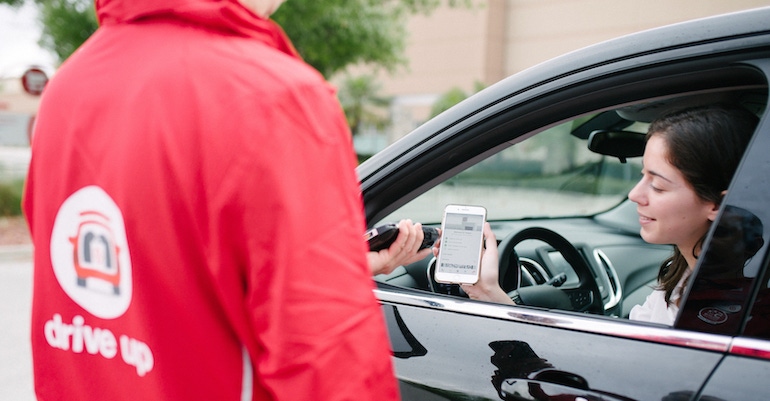Target’s Q3 comparable sales leap almost 21%
Digital sales up 155% as retailer posts record-high adjusted EPS
November 18, 2020

Fueled by booming e-commerce business, Target Corp. topped 20% sales growth in its fiscal 2020 third quarter, with Chairman and CEO Brian Cornell citing record-high adjusted earnings per share that more than doubled versus a year ago.
Minneapolis-based Target said Wednesday that, for the quarter ended Oct. 31, net sales rose 21.3% to $22.34 billion from $18.41 billion a year earlier. Total revenue also was up 21.3%, reaching $22.63 billion.
Overall comparable sales jumped 20.7% year over year, reflecting gains of 9.9% in same-store sales and 155% in digital sales. Traffic increased 4.5% on a comparable basis, while the average ticket grew 15.6%.

“Since the pandemic began in March, we have experienced a meaningful acceleration in basket growth, both in stores and online, as guests have consolidated their shopping into much larger trips,” Cornell (left) told analysts in a conference call on Wednesday. “Across channels, our store comps grew nearly 10%, while our digital comp sales grew 155%, contributing nearly 11 percentage points to the company comp.”
Sales via same-day services Order Pick Up (in-store pickup), Drive Up (curbside pickup) and Shipt (home delivery) climbed by a combined 217% in the quarter, Target reported.
“Within digital, we continue to see the strongest growth in our same-day services: [Order] Pick Up, Drive Up and Shipt, which together grew more than 200% in the quarter,” said Cornell. “These services are fast, convenient, reliable and contactless, which explains why they continue to generate very high levels of guest satisfaction.”
According to Chief Operating Officer John Mulligan, same-day services added more than $1 billion of incremental sales in the third quarter.
“Nearly $700 million of this growth was from our Drive Up service alone, which increased more than 500% compared with last year. Amazingly, this growth was not at the expense of in-store pickup, which increased more than 50%. And while Shipt remains the smallest of our same-day services, it continues to grow rapidly, as Target sales on Shipt increased nearly 280% in the quarter, accounting for more than $200 million of incremental sales,” Mulligan said.
The two executives pointed to Target’s “stores as hubs” model for driving the strong omnichannel sales results, with Mulligan noting that the strategy “allowed our team to pivot seamlessly when guests moved their shopping between stores and our digital channels.” Stores orignated 84.3% of Target’s sales in the quarter versus 15.7% for digital.
“Specifically, same-day orders are fulfilled by our store teams along with Shipt shoppers, who rely on store inventory and systems to deliver to the front of our stores, our parking lots or guests’ front doors within a couple of hours of receiving an order,” Cornell explained, adding that same-day fulfillment also aids Target’s P&L by reducing shipping costs.
“Altogether between same-day services and packages shipped to our guests, about 75% of our third-quarter digital sales were fulfilled by our stores. And of course, if you add that on to our conventional-store sales of more than $18 billion, you can see that more than 95% of our total third-quarter sales were fulfilled by our stores,” Cornell told analysts. “This ‘stores as hubs’ model is a foundational element of our strategic plan we announced at the beginning of 2017, just over three years ago. Our performance for the first three quarters of 2020, which includes digital sales growth of nearly $6.5 billion and a store sales increase of more than $3.5 billion, is a direct result of our ‘stores as hubs’ strategy, combined with the tireless work of our team to bring it to life.”

COO John Mulligan said Target's
At the bottom line, Target posted third-quarter net income of $1.01 billion, or $2.02 per diluted share, compared with $714 million, or $1.40 per diluted share, a year ago. On an adjusted basis, excluding a loss on debt extinguishment and other items, EPS from continuing operations was $2.79 per diluted share versus $1.36 in the prior-year period. Target said the strong earnings result offset continued investments in employee pay and benefits and worker and customer safety measures amid the COVID-19 pandemic.
“Our third-quarter adjusted EPS of $2.79 established another record high for the company and was up more than 100% from last year,” Cornell said.
Analysts, on average, projected Target’s third-quarter adjusted EPS at $1.60, with estimates ranging from a low of $1.13 to a high of $2.01, according to Refinitiv/Thomson Reuters.
“With the deepening level of trust our guests are placing in our team and our brand, we continue to see very strong business results. Third-quarter sales grew nearly $4 billion over last year, bringing our year-to-date growth to more than $10 billion,” Cornell said in the call. “This unprecedented growth both in the quarter and the year has been driven by meaningful share gains across every one of our core categories, as guests increasingly rely on Target to reliably and safely serve their wants and needs. Based on the cost of leverage driven by steeply higher sales, our business continued to deliver impressive bottom-line performance despite the outside investments we have been making in our team, safety and digital fulfillment.”
Target finished the third quarter with 1,897 stores overall, up from 1,868 at the end of the second quarter and 1,862 a year ago. Mulligan reported that 18 new stores were opened in October alone.
“For the year, our team successfully opened 30 new stores, of which 29 were small formats, making 2020 the biggest year of small-format openings ever,” he said. “In any year, setting records would be notable. But in a year in which COVID caused it to delay our new-store construction, it has been amazing to watch how quickly our team was able to restart such a large number of projects and successfully bring them to completion in advance of the holiday season.”
For our most up-to-date coverage, visit the coronavirus homepage.
About the Author
You May Also Like






